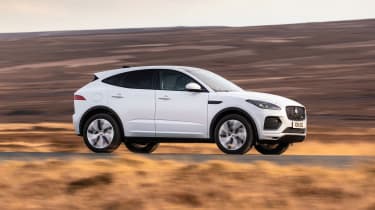Jaguar E-Pace review - MPG, running costs & CO2 (2018-2024)
The E-Pace isn't a class leader in economy terms but it's not bad either
Jaguar has a reputation for producing performance cars but the E-Pace is targeted squarely at families, so it has a greater focus on efficiency than outright performance. However, the E-Pace isn't quite a class-leader in economy terms, so you may be better off in one of its rivals if running costs are a primary concern. The equivalent BMW X1, for example, is capable of around 50mpg. The most economical non-hybrid E-Pace will do 45mpg.
A major update for 2021 also ushered in a PHEV version, giving the E-Pace a major shot in the arm for economy-minded private buyers and business drivers facing hefty Benefit-in-Kind (BiK) tax elsewhere in the range.
Jaguar E-Pace MPG & CO2
The most economical E-Pace in the standard range is the D165, which is the entry-level, front-wheel drive diesel. It claims fuel economy of up to 45.6mpg and CO2 emissions of starting at 162g/km, with economy falling slightly if you opt for bigger wheels. The same engine with four-wheel drive and an automatic transmission returns fuel economy up to 43.4mpg and emission starting at 162g/km. This means that the D165 occupies the top BiK bracket for company-car drivers.
Move up to the more powerful D200 diesel, which is only available with four-wheel drive and an automatic gearbox, and it returns up to 43.9mpg with CO2 emissions starting from 171g/km.
More reviews
In-depth reviews
Both petrol engines are relatively powerful and come with automatic gearboxes and four-wheel drive as standard, so they aren’t cheap to run. The P250 claims up to 31.2mpg with CO2 emissions starting from 204g/km upwards. The petrol E-Paces offers similar economy to the Audi Q3 40 TFSI, but the BMW X1 xDrive20i is slightly more efficient at around 38mpg.
The E-Pace 300 Sport is the most powerful of the regular petrol engines and is a standalone model in the range. It won’t cost much more to run than the lesser petrol engines either, with an official economy figure of up to 29.8mpg and CO2 emissions of 214g/km.
With a 15kWh battery and electric motor fitted alongside a small 1.5-litre petrol engine, the P300e PHEV should be far cheaper to run. Thanks to its ability to drive for up to 38 miles on electricity alone, its official figures of 141mpg and 44g/km of CO2 are way ahead of the petrol and diesel versions. Perhaps even more importantly for company-car drivers, it also sits in a considerably lower BiK band. Charging the battery to 80% takes around 1.5 hours using a 7kW wallbox, while 32kW DC charging (like you might find at a public charger) drops this to just 30 minutes. The latter is also something of a rarity, as not many PHEVs offer fast charging.
The entry-level D165 equipped with a manual gearbox is liable for the standard VED (road tax) rate, while all other versions including the PHEV will cost the discounted VED rate. Be aware that the majority of the E-Pace range straddles the £40,000 threshold, so some of the more expensive models will incur the annual surcharge during years two to six of ownership.
Insurance groups
The entry-level E-Pace D165 sits in insurance group 29, while upgrading to the D200 in R-Dynamic trim bumps this up to group 34 - fairly high ratings for a family SUV. The P300e in R-Dynamic Black trim could be even more costly to cover, in group 40 out of 50.
Warranty
Jaguar provides a three-year warranty on all its new cars, which is very similar to those provided by Audi, BMW and Mercedes. There is the option to buy an extended warranty to cover the car when the first three years has elapsed.
Servicing
Service intervals are every year and you have the option to purchase a five-year/50,000-mile service plan, priced according to whether you have a petrol or diesel E-Pace.










